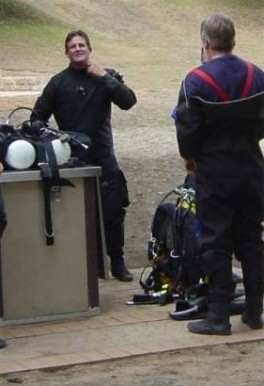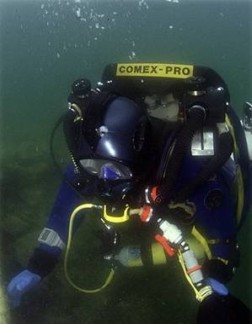Trimix: Because it’s there!
© David Strike. February 2006
“Because it’s there!”
by David Strike
An activity that only a decade ago was widely considered to be beyond the scope and purpose of recreational diving, technical diving has now come in from the cold to play a leading role in the development of programmes and practices that have opened up a whole new world of exciting underwater discoveries and possibilities.
Although still regarded as a niche component of the recreational diving market, the demand for technical diving training is growing rapidly. Not least for the fact that its strict disciplines offer opportunities to perform dives that, in the past, were considered foolish and unsafe.
But despite its broadening appeal, (coupled with a general acceptance of the fact that improvements in equipment and techniques have  made it possible for people to dive beyond their previous comfort zone) technical diving still arouses much curiosity. Not least from those who wonder what it is that drives otherwise seemingly sensible people to want to commit themselves to a challenging activity fraught with risk?
made it possible for people to dive beyond their previous comfort zone) technical diving still arouses much curiosity. Not least from those who wonder what it is that drives otherwise seemingly sensible people to want to commit themselves to a challenging activity fraught with risk?
In 1923, when asked why he wanted to conquer the then un-climbed Mount Everest, the British-mountaineer, George Mallory, simply said, “Because it’s there.” Considered to be the most accomplished climber of his time and despite, by the standards of the day, being well equipped for his attempt on the world’s highest peak, both Mallory and his climbing companion, Andrew Irvine, failed to return from that final push to the summit.
Although it may never be known whether or not the pair reached the world’s highest point, their deaths didn’t deter others from making a similar attempt. Eventually Everest succumbed, and today is regularly climbed by men and women of all ages and physical ability; and who, when asked why they did it, often answer with Mallory’s own words, “Because it’s there.”
What Mallory and Irvine failed to achieve through dogged single-mindedness, others, (equally determined to challenge themselves and push the limits of the envelope just a little further) managed to accomplish with the use of better technology and improved techniques. In that regard diving – and technical diving in particular – bears striking similarities to the assault on Mount Everest.
Historically, of course, diving has always been dependent upon technology; a fact that often creates confusion about the meaning of the phrase, ‘technical diving’ and what it is that differentiates a technical diver from a recreational diver?
A term first coined by Michael Menduno, (the former editor and publisher of ‘aquaCORPS’ magazine) in 1991, technical diving was originally defined as, “… a discipline that uses special tools and methods to improve underwater safety and performance enabling a diver to conduct operations in a wide range of environments and perform tasks beyond the scope of recreational diving."
It’s a general description that still holds true despite later attempts to define it in more precise terms as an activity that meets the following requirements:
-
Takes place in water depths greater than 40-metres.
-
Uses breathing mixtures other than compressed air.
-
Is in an overhead environment, (such as a cave or wreck).
-
Incurs decompression obligations.
-
Requires specialised equipment and training.
But even those explanations fall short of adequately describing exactly what technical diving is? And what it is not! In some regions of the world 50-metres is still regarded as the defining depth limit for recreational diving; while nitrox, once considered to be a voodoo gas unsuited to recreational diving use, has now entered the mainstream of most training agency curriculums.
The fact is that very few of the early technical diving pioneers considered themselves to be anything other than recreational divers. Driven by curiosity about what might lie within the confines of a wreck or a cave, or what hitherto undiscovered life forms lurk in the deeper ocean trenches, the majority pushed themselves to the limits of their knowledge and equipment – sometimes with dire results.
Often regarded as pariahs by the mainstream diving organizations, but gradually acquiring a wealth of trial and error knowledge about how to perform extreme dives more safely, the world’s embryonic technical diving community achieved reluctant legitimacy with the establishment of their own specialised training organizations.
Pooling their combined knowledge and experiences, and sometimes even adapting and refining techniques already proven by the commercial or military diving sectors, (whose earlier big-budget research programmes had traditionally provided the recreational market with, for example, information about decompression procedures and the physiological implications of pressure) these organizations began to put in place their own structured training programmes.
Intended to give divers an edge when contemplating extreme dives beyond the usually accepted limits of depth and time in a variety of hostile environments, many of the techniques first pioneered by divers involved in cutting edge exploration began to percolate through to the broader diving community.
It’s a role reversal that has not only helped stimulate an awareness of technical diving’s possibilities, but one that’s had a profound effect on the perceptions that many have towards this aspect of diving.
No longer restricted in its appeal to the true adventurer, the increasing demand for technical diver training courses has helped create the illusion that it’s something within almost everyone’s capabilities; and that all that’s required to safely perform dives once regarded as foolhardy and dangerous is a certification card and the appropriate equipment.
Often lacking the mental discipline to constantly practice and refine the skills that they’ve been taught, (and then setting out to apply them cautiously and gradually) some divers regard completion of a programme as an end in itself, a badge of distinction that adds to their status as a diver. Many will never even contemplate a dive beyond the defining limits and barriers of their previous experience!
A few will immediately attempt dives that, while within the established parameters of the respective training programme, still remains beyond their present level of skill and mental aptitude to perform safely without some form of direct supervision.
Others become captivated by the technology. Rather than regarding the equipment as a means to an end, and something that should be selected for its relevance to the safety of each planned dive, some people allow the apparatus to dictate the sort of diving that they do. Particularly when, for example, they’ve made a huge capital outlay on an equipment item – a rebreather, say - and begrudge investing the additional money and time to become properly trained in its use. (In this context, ‘properly trained’, extends well beyond the mere completion of a certification programme. Knowing how to use an equipment item is meaningless until the user reaches that point in their training where the requisite safety drills become second nature.)
example, they’ve made a huge capital outlay on an equipment item – a rebreather, say - and begrudge investing the additional money and time to become properly trained in its use. (In this context, ‘properly trained’, extends well beyond the mere completion of a certification programme. Knowing how to use an equipment item is meaningless until the user reaches that point in their training where the requisite safety drills become second nature.)
It’s an increasingly more commonplace attitude and one that’s usually based on the false premise that the person’s previous diving experience has provided them with sufficient knowledge to teach themselves! An approach that ignores that old adage of never allowing any piece of diving equipment to take you to places where your mind hasn’t been at least an hour beforehand!
They’re minority attitudes, but ones that are becoming increasingly more commonplace and that diminish the achievements of those who regard the wreck-site, cave, or deep ocean drop-off as the place where knowledge ends and discovery begins; those true exploration divers who view the necessary equipment and techniques as nothing more than important tools that allow them to satisfy their curiosity about the world in which they live.
In 1998, in an ongoing project to chart the subterranean water flows beneath the Florida land mass, Jarrod Jablonski (the subsequent founder and President of Global Underwater Explorers, one of the world’s most innovative Technical Diving training organizations) together with the then Project Director, George Irvine, established the world’s longest and deepest cave-diving penetrat ion, a staggering underwater distance of 18,000 feet at a depth of 300 feet.
ion, a staggering underwater distance of 18,000 feet at a depth of 300 feet.
It was a dive whose every detail had been scrupulously planned and that relied for its success on experience, fitness, teamwork, training, skill, motivation, and the use of the right equipment, key elements that are now generally regarded as being fundamental to technical diving. More importantly, perhaps, it was a dive with a purpose, one in which the establishment of dual cave diving records was an inconsequential by-product of a desire to further scientific knowledge.
Driven by that same urge to look into the unknown, “because it’s there” technical divers will always long to go deeper and further in their explorations. Their capacity to do so safely will always depend on their understanding of the risks, and their ability to reduce them to an acceptable and manageable level.
As Billly Deans, one of the acknowledged pioneers of technical diving, said in 1995, “Technical diving is … a philosophy, a mindset. Everything you do is based on making that dive absolutely perfect because if you don’t account for all of the parameters of the dive you could get killed.
“It’s a constant vigilance that wears on a human being. To do it well you have to live, eat, breathe technical diving.”
Nevertheless there will always be those who fail to make that commitment in attitude and yet still regard themselves as technical divers.
Often acting out of bravado, or because of a need to prove something to themselves, they paradoxically have much in common with those climbers who, in 1978, scaled Everest without the use of oxygen, based on George Mallory’s belief that, “the climber does best to rely on his natural abilities “.
Mallory’s son had a more realistic approach to technology. “To me the only way you achieve a summit is to come back alive. The job is half done if you don't get down again.”
As with any form of diving, the deciding factor when it comes to safe technical diving will always rest with the individual. For those who have the necessary aptitude, attitude and commitment - and who understand the importance of doing it right - longer and deeper dives are an everyday reality, not the game of ‘Russian Roulette’ that they were once considered to be!
And when they’re invited to say why they do it, they can always say, “Because it’s there!”